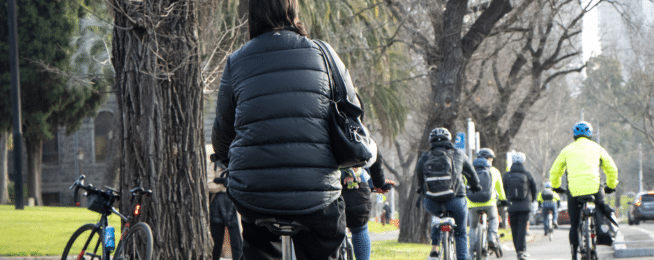The need to slow car traffic in built-up areas and create separation to protect vulnerable road users from vehicles were some of the strongest themes put to the Victorian parliamentary inquiry into road safety last week.
Bicycle Network was one of the key groups called on to present its case for improved road safety to the Legislative Assembly Economy and Infrastructure Committee over a two-day hearing.
Bicycle Network Board President James Garriock told the inquiry that it was important for the community to see bike riders as ordinary people riding to work, riding for fun and riding for, and with, their families.
“We have almost 50,000 members … and they ask us to advocate for better and safer riding conditions, and that includes paths, trails and roads, road rules, road conditions, road behaviours and transport policy, so this inquiry is a top priority for us.
“The cost of death and injury to our vulnerable road users is definitely in the hundreds of millions of dollars, and that is before we put a value on the trauma caused to the victims, their families, their friends and their communities.
“Our members think that that money would be far better spent making bike riding easier and safer for everyone.”
The parliamentary inquiry into the impact of road safety behaviours on vulnerable road users looked at how behaviours changed during and after the COVID-19 pandemic. It is considering the impact of these changes on vulnerable road users including pedestrians, bike riders, children, older people and mobility device users.
In May, more than 3000 Bicycle Network members and friends responded to a survey, which we used to inform our submission to the inquiry. Bicycle Network Chief Executive Officer Alison McCormack thanked everyone for their “honest and detailed responses”.
Some of the strongest themes that emerged from our survey were respondent’s concerns about driver attitudes to bike riders, priority delivery of separated and dedicated bike lanes, bike lane and path network improvement, bike rider safety around building works and the need to humanise bike riders.
The key recommendations in our submission called for:
- Enforcement of rule 144A of the Road Safety Road Rules (keeping a sufficient distance when passing to the right side of a bicycle or electric scooter)
- Improved bike riding infrastructure including separated bike paths, connected routes and safe shoulders on major Victorian roads
- Funding for local governments to implement their cycling strategies
- A statewide campaign to improve driver attitudes and behaviours towards vulnerable road users
- Risk management plans for building sites that include the introduction of safety measures for vulnerable road users
- A public state government response to coroner recommendations following the death of a bike rider
- Fast-tracked requirements for driver-assist technology for light and heavy vehicles.
You can view our submission here
Other groups heard by the parliamentary committee included bicycle user groups, walking groups, the Municipal Association of Victoria RACV, Victoria Police, the Transport Accident Commission and the Department of Transport and Planning.
Bicycle Network Senior Policy Advisor Garry Brennan told the committee that effective community engagement, particularly in suburban areas, was vital to ensure changes to existing infrastructure improved safety for bike riders.
“Every new proposal to give bike riders or pedestrians more space will attract opposition initially. Over time, once people see it in place and they begin to use it, that opposition fades away, and after a number of years the people who opposed its introduction would oppose its removal,” Brennan said.
Brennan also called for an action plan to map out the delivery of the Victorian Cycling Strategy 2019-2028.
“We need a systematic approach to the recommendations in the strategy. They need to be scheduled, and they need to be put into a pipeline that looks ahead for a number of years.
“That gives councils and other agencies the ability to look at what is going on with things such as strategic cycling corridors and major bridges—and the projects that are dropping out of level crossings—and work out where their connections can slot in and gain the full benefits of joining the network up.”
Become our friend
Find out more about Bicycle Network and support us in making it easier for people to ride bikes.


